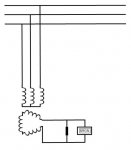That Man
Member
- Location
- California, United States
- Occupation
- Electrical Designer
Mike Holt Community,
One of the senior electricians at my company called and asked me a question about a solar install.
First some background of the install: Between the inverter at the solar array and the loads being fed, there is a pair of step up and step down transformers. 480Y to 4160 Delta step up, 4160 Delta to 480Y step down.
The question: Where do you land the neutral between the transformers?
Simple Answer: I told him that there is no neutral between delta winding and delta winding.
His concern arises from the fact that he's been on several sites with the same scenario, and there has been neutrals present.
Because I don't know what I don't know, and I don't have much experience with solar installations, I'd like to know if anyone out there knows of some other reason to run a neutral in the scenario I described.
One of the senior electricians at my company called and asked me a question about a solar install.
First some background of the install: Between the inverter at the solar array and the loads being fed, there is a pair of step up and step down transformers. 480Y to 4160 Delta step up, 4160 Delta to 480Y step down.
The question: Where do you land the neutral between the transformers?
Simple Answer: I told him that there is no neutral between delta winding and delta winding.
His concern arises from the fact that he's been on several sites with the same scenario, and there has been neutrals present.
Because I don't know what I don't know, and I don't have much experience with solar installations, I'd like to know if anyone out there knows of some other reason to run a neutral in the scenario I described.


